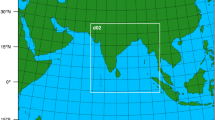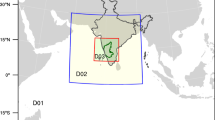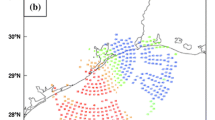Abstract
Uncertainties in the numerical weather prediction models are generally not well-represented in ensemble-based data assimilation (DA) systems. The performance of an ensemble-based DA system becomes suboptimal, if the sources of error are undersampled in the forecast system. The present study examines the effect of accounting for model error treatments in the hybrid ensemble transform Kalman filter—three-dimensional variational (3DVAR) DA system (hybrid) in the track forecast of two tropical cyclones viz. Hudhud and Thane, formed over the Bay of Bengal, using Advanced Research Weather Research and Forecasting (ARW-WRF) model. We investigated the effect of two types of model error treatment schemes and their combination on the hybrid DA system; (i) multiphysics approach, which uses different combination of cumulus, microphysics and planetary boundary layer schemes, (ii) stochastic kinetic energy backscatter (SKEB) scheme, which perturbs the horizontal wind and potential temperature tendencies, (iii) a combination of both multiphysics and SKEB scheme. Substantial improvements are noticed in the track positions of both the cyclones, when flow-dependent ensemble covariance is used in 3DVAR framework. Explicit model error representation is found to be beneficial in treating the underdispersive ensembles. Among the model error schemes used in this study, a combination of multiphysics and SKEB schemes has outperformed the other two schemes with improved track forecast for both the tropical cyclones.










Similar content being viewed by others
References
Berner, J., Fossell, K., Ha, S.-Y., Hacker, J., & Snyder, C. (2015). Increasing the skill of probabilistic forecasts: Understanding performance improvements from model-error representations. Monthly Weather Review, 143, 1295–1320.
Betts, A. K., & Miller, M. J. (1993). The Betts–Miller scheme. The Representation of Cumulus Convection in Numerical Models (pp. 107–121). New York: Springer.
Bishop, C. H., Etherton, B. J., & Majumdar, S. J. (2001). Adaptive sampling with the ensemble transform Kalman filter. Part I: Theoretical aspects. Monthly Weather Review, 129, 420–436.
Buehner, M. (2005). Ensemble-derived stationary and flow-dependent background-error covariances: Evaluation in a quasi-operational NWP setting. Quarterly Journal of the Royal Meteorological Society, 131, 1013–1043.
Courtier, P., et al. (1998). The ECMWF implementation of three-dimensional variational assimilation (3D-Var). I: Formulation. Quarterly Journal of the Royal Meteorological Society, 124, 1783–1807.
Evensen, G. (2003). The ensemble Kalman filter: Theoretical formulation and practical implementation. Ocean Dynamics, 53, 343–367.
Grell, G. A., & Dévényi, D. (2002). A generalized approach to parameterizing convection combining ensemble and data assimilation techniques. Geophysical Research Letters, 29, 1693.
Ha, S., Berner, J., & Snyder, C. (2015). A comparison of model error representations in mesoscale ensemble data assimilation. Monthly Weather Review, 143, 3893–3911.
Hamill, T. M. (2006). Ensemble-Based Atmospheric Data Assimilation: Predictability of Weather and Climate (pp. 124–156). Cambridge: Cambridge University Press.
Hamill, T. M., & Snyder, C. (2000). A hybrid ensemble Kalman filter-3D variational analysis scheme. Monthly Weather Review, 128, 2905–2919.
Hong, S.-Y., Dudhia, J., & Chen, S.-H. (2004). A revised approach to ice microphysical processes for the bulk parameterization of clouds and precipitation. Monthly Weather Review, 132, 103–120.
Hong, S.-Y., Noh, Y., & Dudhia, J. (2006). A new vertical diffusion package with an explicit treatment of entrainment processes. Monthly Weather Review, 134, 2318–2341.
Hong, S.-Y., & Pan, H.-L. (1996). Nonlocal boundary layer vertical diffusion in a medium-range forecast model. Monthly Weather Review, 124, 2322–2339.
Houtekamer, P. L., & Mitchell, H. L. (2001). A sequential ensemble Kalman filter for atmospheric data assimilation. Monthly Weather Review, 129, 123–137.
Janjić, Z. I. (1994). The step-mountain eta coordinate model: Further developments of the convection, viscous sublayer, and turbulence closure schemes. Monthly Weather Review, 122, 927–945.
Kain, J. S., & Fritsch, J. M. (1993). Convective Parameterization for Mesoscale Models: The Kain–Fritsch Scheme. The Representation of Cumulus Convection in Numerical Models (pp. 165–170). New York: Springer.
Kessler, E. (1995). On the continuity and distribution of water substance in atmospheric circulations. Atmospheric Research, 38, 109–145.
Kutty, G., & Wang, X. (2015). A comparison of the impacts of radiosonde and AMSU radiance observations in GSI based 3DEnsVar and 3DVar data assimilation systems for NCEP GFS. Advances in Meteorology, 2015, 1–17.
Li, Y., Wang, X., & Xue, M. (2012). Assimilation of radar radial velocity data with the WRF hybrid ensemble–3DVAR system for the prediction of hurricane Ike (2008). Monthly Weather Review, 140, 3507–3524.
Lin, Y.-L., Farley, R. D., & Orville, H. D. (1983). Bulk parameterization of the snow field in a cloud model. Journal of Climate and Applied Meteorology, 22, 1065–1092.
Lorenc, A. C. (2003). The potential of the ensemble Kalman filter for NWP—a comparison with 4D-Var. Quarterly Journal of the Royal Meteorological Society, 129, 3183–3203.
Meng, Z., & Zhang, F. (2007). Tests of an ensemble Kalman filter for mesoscale and regional-scale data assimilation. Part II: Imperfect model experiments. Monthly Weather Review, 135, 1403–1423.
Nakanishi, M., & Niino, H. (2006). An improved Mellor–Yamada level-3 model: Its numerical stability and application to a regional prediction of advection fog. Boundary-Layer Meteorology, 119, 397–407.
Parrish, D. F., & Derber, J. C. (1992). The national meteorological center’s spectral statistical-interpolation analysis system. Monthly Weather Review, 120, 1747–1763.
Schwartz, C. S., Liu, Z., Huang, X.-Y., Kuo, Y.-H., & Fong, C.-T. (2013). Comparing limited-area 3DVAR and hybrid variational-ensemble data assimilation methods for typhoon track forecasts: Sensitivity to outer loops and vortex relocation. Monthly Weather Review, 141, 4350–4372.
Shutts, G. (2005). A kinetic energy backscatter algorithm for use in ensemble prediction systems. Quarterly Journal of the Royal Meteorological Society, 131, 3079–3102.
Skamarock, W. C., et al. (2008). A description of the advanced research WRF version 3. NCAR Technical Note NCAR/TN-475 + STR, 2008, 113.
Thompson, G., Field, P. R., Rasmussen, R. M., & Hall, W. D. (2008). Explicit forecasts of winter precipitation using an improved bulk microphysics scheme. Part II: Implementation of a new snow parameterization. Monthly Weather Review, 136, 5095–5115.
Torn, R. D., Hakim, G. J., & Snyder, C. (2006). Boundary conditions for limited-area ensemble Kalman filters. Monthly Weather Review, 134, 2490–2502.
Wang, X. (2011). Application of the WRF Hybrid ETKF–3DVAR data assimilation system for hurricane track forecasts. Weather and Forecasting, 26, 868–884.
Wang, X., Barker, D. M., Snyder, C., & Hamill, T. M. (2008). A hybrid ETKF–3DVAR data assimilation scheme for the WRF model. Part I: Observing system simulation experiment. Monthly Weather Review, 136, 5116–5131.
Whitaker, J. S., & Hamill, T. M. (2012). Evaluating methods to account for system errors in ensemble data assimilation. Monthly Weather Review, 140, 3078–3089.
Wu, W.-S., Purser, R. J., & Parrish, D. F. (2002). Three-dimensional variational analysis with spatially inhomogeneous covariances. Monthly Weather Review, 130, 2905–2916.
Acknowledgements
The authors thank the supercomputing facility of Indian Institute of Tropical Meteorology, Pune for providing computational resources and NCAR for WRF model.
Author information
Authors and Affiliations
Corresponding author
Rights and permissions
About this article
Cite this article
Kutty, G., Muraleedharan, R. & Kesarkar, A.P. Impact of Representing Model Error in a Hybrid Ensemble-Variational Data Assimilation System for Track Forecast of Tropical Cyclones over the Bay of Bengal. Pure Appl. Geophys. 175, 1155–1167 (2018). https://doi.org/10.1007/s00024-017-1747-z
Received:
Revised:
Accepted:
Published:
Issue Date:
DOI: https://doi.org/10.1007/s00024-017-1747-z




